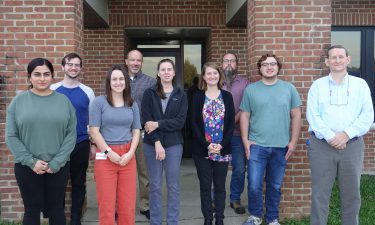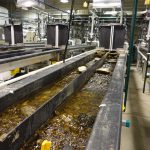A success story: Office of Environmental Quality celebrates 25 years

BATAVIA, OH — In a non-descript building tucked off a bend in State Route 50, near Interstate 275, small teams from Clermont County’s Office of Environmental Quality (OEQ) and the U.S. Environmental Protection Agency (USEPA) diligently work to keep our water safe.
A lab manager, chemist and three lab techs, who are key members of the OEQ team, work to test wastewater from four Clermont County treatment plants as well as 10 facilities in the City of Milford, New Richmond and other areas. They ensure that water meets safety standards before its release back into the environment.
Meanwhile, a research scientist from the USEPA and his team perform tests at the only Experimental Stream Facility of its type in the country. The facility replicates the natural world in a controlled environment, allowing the USEPA to study simulated streams in Clermont County and other locations. They test the effects of various chemicals on fish and macroinvertebrates and the results inform the development of water quality standards.
“The USEPA helps us with our local watershed program, and they also have a lot of other research projects underway,” said Hannah Lubbers, OEQ director. “The technical expertise they provide the county is of tremendous value to the region. This partnership, combined with other federal, state and local agencies is unique and helps us to address the challenges that led to formation of the Office of Environmental Quality 25 years ago.”
The OEQ story began in 1996, a year when Clermont County was experiencing rapid growth. In response, the county developed a wastewater master plan to ensure that growth and development occurred in a sustainable manner. The Board of County Commissioners recognized the importance of resource protection and charged OEQ to become the local experts on water quality.
“One of the main reasons for forming the Office of Environmental Quality was to protect the quality of water in Clermont County,” Lubbers said. She credits then-Director Paul Braasch with leading efforts to maintain local control over water resources.
The office is a joint department under Clermont County Water Resources, also doing work in Adams County as part of the Adams-Clermont Solid Waste District. It provides waste and recycling guidance to the public, does recycling programs in offices and schools, gives educational programs, and operates a waste transfer facility in Adams County. OEQ is also responsible for monitoring the CECOS landfill for regulatory compliance and water quality, as well as operating the Wastewater Laboratory on SR 50 in Milford. Additional responsibilities include partnering with the local Emergency Management Agency to respond to floods and tornadoes.
Several years after establishing the OEQ and a Wastewater Master Plan, Clermont County received ownership of the Experimental Stream Research facility (ESF) from Procter & Gamble. OEQ secured a partnership with a renowned research scientist at the USEPA, Chris Nietch, to lease the facility for watershed research. The research that has since been done in Clermont County and neighboring counties fostered a unique partnership among federal, state and local governments.
In 2008, this group of agencies with a common interest in water resource protection formed the East Fork Watershed Cooperative (EFWCoop). The EFWCoop, which includes OEQ, USEPA, Clermont Soil & Water Conservation District, Clermont County Water Resources, the Natural Resources Conservation Service (an agency of the U.S. Department of Agriculture), United States Army Corp, Ohio Department of Natural Resources, Clermont County Park District and local stakeholders, began meeting regularly and combined resources to enhance local and regional efforts. As a result, the East Fork of the Little Miami has become a test bed for watershed research and management practices.
As the EFWCoop built a comprehensive water monitoring system, OEQ set about creating an in-house water quality program to identify priority management areas and assess long-term trends. The program has achieved Level 3 certification, the highest given by the Ohio Environmental Protection Agency. Over the years, OEQ has sampled many sites in the East Fork watershed. This helps identify areas of high pollution that can be targeted for practices to reduce contamination. This information, along with results from a watershed model developed by USEPA, is used to prioritize areas for management practices when funding becomes available.
“A major threat to water quality in this area is nutrient loading, which is basically too much nitrogen and phosphorus in streams coming from multiple sources,” Lubbers said. “This type of pollution, called non-point source pollution, is what Clermont County is focused on managing.”
Non-point source pollution (NPS) is runoff from rainfall or snow melt that washes pollutants off the landscape and into nearby streams. Nutrients from fertilizers and failing septic systems are the main source of pollution in this region and are the main cause of Harmful Algal Blooms in East Fork Lake. Land use above the lake is primarily agricultural.
“Agricultural best management practices, or BMPs, such as cover crops and no-till, are the best avenue to reduce nutrient runoff in the watershed,” Lubbers said. With the help of the EFWCoop, cover crop acreage has increased dramatically in the region and landowner interest in other BMPs is growing.
In addition to agricultural practices, many other watershed projects have provided water quality benefits. Clermont County OEQ has been instrumental in helping partner agencies secure more than $9 million in grant funding to remove low-head dams, restore stream habitat and implement storm water improvement practices. A recent study revealed the East Fork Little Miami River is meeting water quality standards downstream of East Fork Lake, where most of the waste water treatment plants are located. Prior to gaining a better understanding of NPS runoff, treatment plants were thought to be the main sources of pollution.
“We think many of the watershed management projects and practices implemented in the lower East Fork of the Little Miami River have contributed to that section of river being in attainment of state water quality standards,” Lubbers said. Because the river is in good condition, the treatment plants won’t be burdened with stricter nutrient limits.
The East Fork Little Miami River watershed is now regarded as one of the most comprehensive and effective watershed management programs throughout Ohio. The strength of the local partnerships has directed attention and grant dollars from northern Ohio and Lake Erie, to southern Ohio and the vitally important watersheds of the Ohio River.
“While the county and region continue to grow and develop, Clermont OEQ and its many partners will carry on our work to help ensure the rural nature of the region is preserved so our growing populations can continue to enjoy Clermont County’s abundant natural resources,” Lubbers said.
